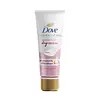What's inside
What's inside
 Key Ingredients
Key Ingredients

 Benefits
Benefits

 Concerns
Concerns

 Ingredients Side-by-side
Ingredients Side-by-side

Water
Skin ConditioningGlycerin
HumectantCocamidopropyl Betaine
CleansingSodium Laureth Sulfate
CleansingSodium Hydrolyzed Potato Starch Dodecenylsuccinate
Avena Sativa Kernel Flour
AbrasiveYogurt Powder
Guar Hydroxypropyltrimonium Chloride
Skin ConditioningPolyquaternium-10
Acrylates/C10-30 Alkyl Acrylate Crosspolymer
Emulsion StabilisingSodium Chloride
MaskingGlycol Distearate
EmollientLaureth-4
EmulsifyingTetrasodium Glutamate Diacetate
Citric Acid
BufferingLactic Acid
BufferingSodium Hydroxide
BufferingSodium Benzoate
MaskingParfum
MaskingBenzyl Alcohol
PerfumingBenzyl Salicylate
PerfumingWater, Glycerin, Cocamidopropyl Betaine, Sodium Laureth Sulfate, Sodium Hydrolyzed Potato Starch Dodecenylsuccinate, Avena Sativa Kernel Flour, Yogurt Powder, Guar Hydroxypropyltrimonium Chloride, Polyquaternium-10, Acrylates/C10-30 Alkyl Acrylate Crosspolymer, Sodium Chloride, Glycol Distearate, Laureth-4, Tetrasodium Glutamate Diacetate, Citric Acid, Lactic Acid, Sodium Hydroxide, Sodium Benzoate, Parfum, Benzyl Alcohol, Benzyl Salicylate
Water
Skin ConditioningAluminum Chlorohydrate
AstringentGlyceryl Stearate
EmollientGlycerin
HumectantHelianthus Annuus Seed Oil
EmollientStearyl Alcohol
EmollientNiacinamide
SmoothingSteareth-20
CleansingParfum
MaskingCetearyl Alcohol
EmollientCyclopentasiloxane
EmollientDimethicone Crosspolymer
Emulsion StabilisingTitanium Dioxide
Cosmetic ColorantSteareth-2
EmulsifyingPentaerythrityl Tetra-Di-T-Butyl Hydroxyhydrocinnamate
AntioxidantCollagen Amino Acids
MoisturisingWater, Aluminum Chlorohydrate, Glyceryl Stearate, Glycerin, Helianthus Annuus Seed Oil, Stearyl Alcohol, Niacinamide, Steareth-20, Parfum, Cetearyl Alcohol, Cyclopentasiloxane, Dimethicone Crosspolymer, Titanium Dioxide, Steareth-2, Pentaerythrityl Tetra-Di-T-Butyl Hydroxyhydrocinnamate, Collagen Amino Acids
 Reviews
Reviews

Ingredients Explained
These ingredients are found in both products.
Ingredients higher up in an ingredient list are typically present in a larger amount.
Glycerin is already naturally found in your skin. It helps moisturize and protect your skin.
A study from 2016 found glycerin to be more effective as a humectant than AHAs and hyaluronic acid.
As a humectant, it helps the skin stay hydrated by pulling moisture to your skin. The low molecular weight of glycerin allows it to pull moisture into the deeper layers of your skin.
Hydrated skin improves your skin barrier; Your skin barrier helps protect against irritants and bacteria.
Glycerin has also been found to have antimicrobial and antiviral properties. Due to these properties, glycerin is often used in wound and burn treatments.
In cosmetics, glycerin is usually derived from plants such as soybean or palm. However, it can also be sourced from animals, such as tallow or animal fat.
This ingredient is organic, colorless, odorless, and non-toxic.
Glycerin is the name for this ingredient in American English. British English uses Glycerol/Glycerine.
Learn more about GlycerinParfum is a catch-all term for an ingredient or more that is used to give a scent to products.
Also called "fragrance", this ingredient can be a blend of hundreds of chemicals or plant oils. This means every product with "fragrance" or "parfum" in the ingredients list is a different mixture.
For instance, Habanolide is a proprietary trade name for a specific aroma chemical. When used as a fragrance ingredient in cosmetics, most aroma chemicals fall under the broad labeling category of “FRAGRANCE” or “PARFUM” according to EU and US regulations.
The term 'parfum' or 'fragrance' is not regulated in many countries. In many cases, it is up to the brand to define this term.
For instance, many brands choose to label themselves as "fragrance-free" because they are not using synthetic fragrances. However, their products may still contain ingredients such as essential oils that are considered a fragrance by INCI standards.
One example is Calendula flower extract. Calendula is an essential oil that still imparts a scent or 'fragrance'.
Depending on the blend, the ingredients in the mixture can cause allergies and sensitivities on the skin. Some ingredients that are known EU allergens include linalool and citronellol.
Parfum can also be used to mask or cover an unpleasant scent.
The bottom line is: not all fragrances/parfum/ingredients are created equally. If you are worried about fragrances, we recommend taking a closer look at an ingredient. And of course, we always recommend speaking with a professional.
Learn more about ParfumWater. It's the most common cosmetic ingredient of all. You'll usually see it at the top of ingredient lists, meaning that it makes up the largest part of the product.
So why is it so popular? Water most often acts as a solvent - this means that it helps dissolve other ingredients into the formulation.
You'll also recognize water as that liquid we all need to stay alive. If you see this, drink a glass of water. Stay hydrated!
Learn more about Water